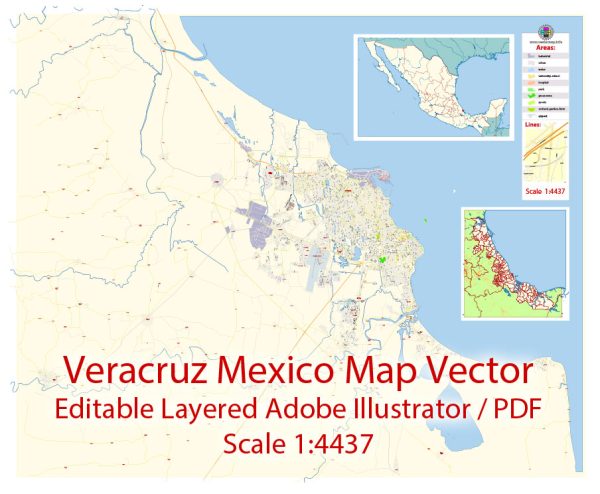Veracruz, located on the Gulf of Mexico, has a rich history of urban development that spans several centuries and reflects its strategic importance as a port city. Here’s an overview of key phases in Veracruz’s urban development:
- Pre-Columbian Era:
- Before the arrival of the Spanish, the area around Veracruz was inhabited by various indigenous groups, including the Totonac people. The Totonacs were known for their advanced agricultural practices and the cultivation of vanilla.
- Spanish Conquest and Early Colonial Period (Early 16th Century):
- Veracruz played a pivotal role in the Spanish colonization of Mexico. In 1519, Spanish explorer Hernán Cortés arrived in Veracruz, and it was from here that he initiated the march to the Aztec capital, Tenochtitlan.
- Due to its strategic location and natural harbor, Veracruz became a key port for Spanish trade and communication with Europe.
- Colonial Period and Fortifications (16th – 18th Centuries):
- Veracruz experienced significant growth during the colonial period. The city became a hub for maritime trade, and the Spanish crown invested in fortifications to protect against pirate attacks.
- The San Juan de Ulúa fortress, located on an island in the harbor, became a symbol of Spanish military strength in the region.
- Trade and Commercial Hub (18th – 19th Centuries):
- Veracruz continued to thrive as a commercial center during the 18th and 19th centuries. The city’s port was a vital link between Mexico and Europe, contributing to economic prosperity.
- The construction of the Veracruz Cathedral, a prominent colonial-era church, added to the city’s architectural heritage.
- Mexican War of Independence (Early 19th Century):
- Veracruz played a role in the Mexican War of Independence (1810-1821). In 1820, Spanish authorities signed the Plan of Iguala in Veracruz, paving the way for Mexican independence.
- French Intervention and Siege of Veracruz (19th Century):
- During the 19th century, Veracruz witnessed the French Intervention in Mexico. In 1862, French forces occupied the city, leading to the Siege of Veracruz. The city’s defenses were eventually breached by the French.
- 20th Century and Modernization:
- In the 20th century, Veracruz continued to modernize. The city became an important center for oil production and export, contributing to economic development.
- The construction of the Veracruz Naval Base and the expansion of the port facilities underscored the city’s strategic significance.
- Cultural Heritage and Tourism (Contemporary):
- Veracruz is known for its vibrant cultural scene, including music, dance, and cuisine. The city hosts the annual Veracruz Carnival, one of the largest in Mexico.
- Tourism has become a significant industry, with visitors drawn to the city’s historical sites, beaches, and cultural events.
- Urban Challenges and Resilience:
- Like many urban centers, Veracruz faces contemporary challenges, including issues related to infrastructure, environmental sustainability, and urban planning. Efforts are underway to address these challenges while preserving the city’s historical character.
Veracruz’s urban development reflects its historical role as a gateway to Mexico and its importance in both colonial and post-colonial eras. The city’s strategic location, vibrant cultural heritage, and economic activities contribute to its continued significance in the region.


 Author: Kirill Shrayber, Ph.D.
Author: Kirill Shrayber, Ph.D.